Philodendron Birkin plants are easy to grow, and don’t require any special care. In this post, I’ll tell you all you need to know in order to keep them thriving for years to come.

The unique striped foliage of Philodendron Birkin makes it a beautiful addition to any indoor plant collection.
It’s easy-to-care for nature also makes it ideal for beginners who want to bring more green into their homes.
This detailed Philodendron Birkin care guide will help anyone learn how to grow them successfully.
Here you’ll find everything from how to provide the correct water, light, humidity, and soil, to how to prune, propagate, and more.
Philodendron Birkin Quick Care Overview
| Scientific name: | Philodendron ‘Birkin’ |
| Classification: | Tropical plant |
| Common names: | Philo Birkin |
| Hardiness: | Zones 10+ |
| Temperature: | 70-85°F |
| Flowers: | N/A |
| Light: | Full to partial shade, bright light indoors |
| Water: | Keep soil evenly moist, do not overwater |
| Humidity: | High |
| Fertilizer: | General purpose plant food spring-summer |
| Soil: | Fast-draining, fertile soil |
| Common pests: | Spider mites, scale, thrips, mealybugs |
Information About Philodendron Birkin
Philodendron Birkin is from the Aroid, or Araceae family that’s native to tropical rainforests of Central and South America.
It’s a hybrid that doesn’t exist in the wild, but was cultivated for the white pinstriped variegation on the deep green, pointed oval leaves.
They’re compact plants that grow on upright, thick, bright green stems. They can reach heights of 3’, with wide leaves spanning up to 7” long.
Toxicity
The Philodendron Birkin is toxic to both humans and pets when ingested. You can refer to the ASPCA website for more information.
If you’re concerned about this, it’s a good idea to keep them out of reach of children, dogs, and cats.
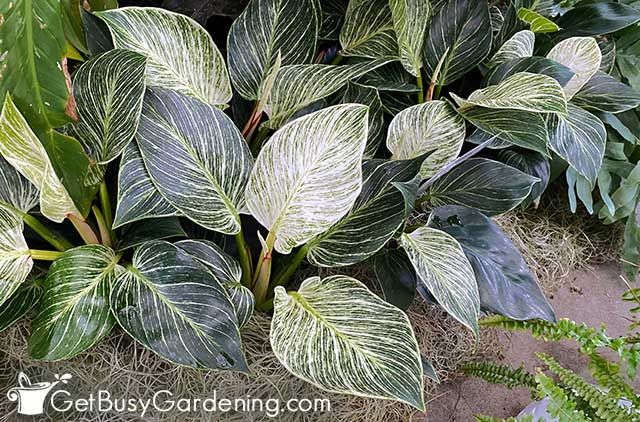
How To Care For Philodendron Birkin
Before we get into the details of Philodendron Birkin care, we should discuss the best location to grow them. Choosing the right spot is key for enjoying the variegated leaves and long-lasting health.
Hardiness
Philodendron Birkin is not a cold hardy plant, and will slow or stop growing when temperatures drop below 60°F.
They’re only hardy outdoors in zones 10+, so most people keep them as indoor plants year round.
If you prefer, you can move it outside during warm months, then bring it indoors before it gets too cold in the fall.
Where To Grow Philodendron Birkin
The best place to grow a Philodendron Birkin is in a humid, bright location protected from direct sunlight.
They need plenty of light to maintain the white coloring, but too much sun exposure will burn them.
To create a good home for them, use a container with ample drainage for best results. In warm enough climates, you can grow them outside in the garden in dappled shade.
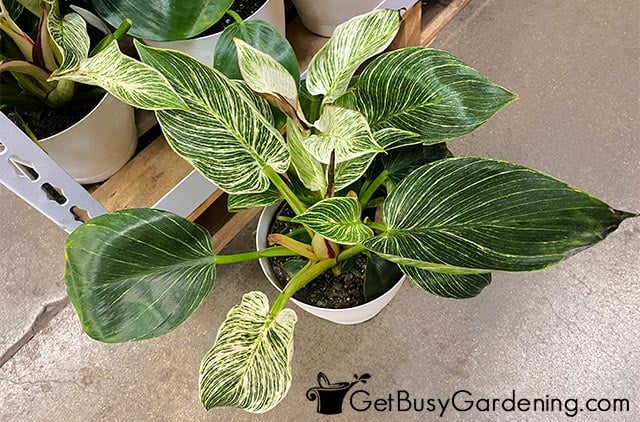
Philodendron Birkin Plant Care & Growing Instructions
Now that you know where to grow them, let’s chat about Philodendron Birkin care. These tips will help you create the ideal environment to keep them healthy.
Light
The best light for Philodendron Birkin is very bright, but indirect or filtered sun. They need about 12 hours to maintain the white stripes on the leaves.
The intense afternoon rays will dry out or burn the leaves, but they’ll tolerate 3-4 hours of direct morning or evening sun.
Indoors place them in a bright location, like an east or west facing window. Use a grow light to supplement if needed.
Water
Consistent, even moisture is key to successful Philodendron Birkin care. They don’t like to dry out for long, but can suffer if left with wet feet.
Wait until the top inch of soil has dried out, then water deeply, draining all excess from the pot. A moisture gauge can help you get it just right.
Humidity
A humid environment is also important, preferably near the 50% range, which you can check with a monitor.
Indoor air is often drier, especially in the winter when heaters are running, so it’s important to watch it.
Keep them near a humidifier, set them on a pebble tray, or mist them regularly to help increase the humidity level.
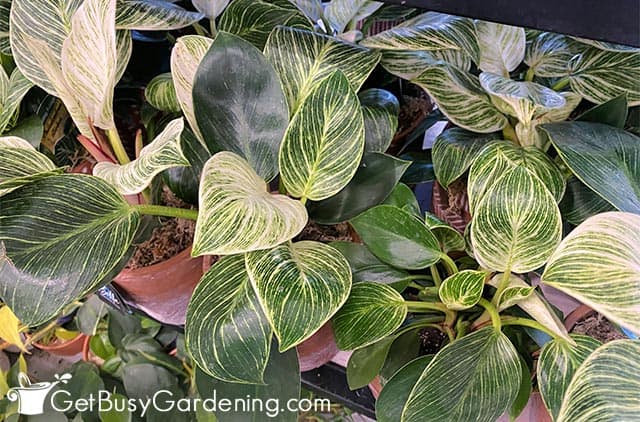
Temperature
The ideal temperature range for Philodendron Birkin is between 70-85°F. Anything outside of that range can affect their health.
They cannot tolerate temperatures lower than 60°F without their growth slowing or stopping. Freezing weather will quickly kill them.
Fertilizer
The occasional feeding can invigorate more rapid growth, especially if they’ve been in the same pot for many years.
Feed them once a month in the spring and summer with an organic houseplant fertilizer or compost tea.
Be cautious about overdoing it though, and don’t use synthetic brands because they can cause fertilizer burn.
Stop fertilizing altogether in the fall and winter, or it could result weak, leggy growth.
Soil
Philodendron Birkin grows best in a fertile, but well-draining, aerated soil mixture.
You can purchase an aroid mix, or create your own by combining regular potting soil with perlite, peat moss, and pine bark.
Repotting
You may only need to repot a Philodendron Birkin once every few years, depending on the environment and how fast it grows.
Size them up when the roots begin to peek from the bottom of the container. Tackle it in the spring, and choose a pot that’s only 1-2” larger with good drainage.
Pruning
Regular Philodendron Brikin care doesn’t require pruning, unless you see dry or damaged leaves, or if growth has become leggy.
In that case, use sharp, clean precision pruners to cut the leaf all the way down to the soil line.
Pest Control Tips
There aren’t many pests that will bother a healthy Philodendron Birkin. But they can fall prey to spider mites, scale, thrips, and mealybugs on occasion.
If you see signs of webbing or insect damage, begin treating the leaves with neem oil or an insecticidal spray.
It’s easy to make your own by mixing 1 teaspoon of mild liquid soap with 1 liter of water.
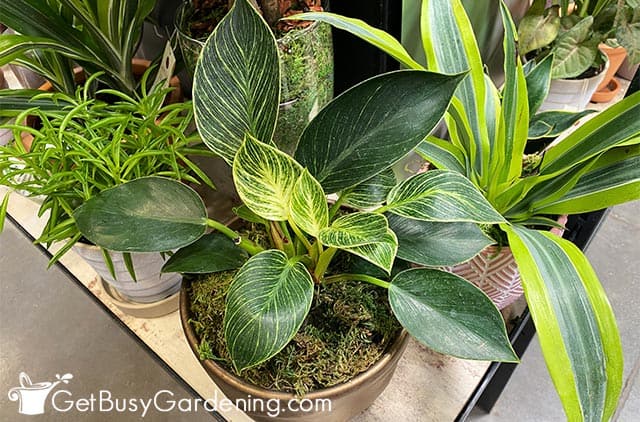
Philodendron Birkin Propagation Tips
You can propagate a Philodendron Birkin by taking stem cuttings or dividing them.
Either method can be done in the spring or summer, during their active growing season.
Cuttings will only work on mature stems that have leaf nodes. Dip the cut ends in rooting hormone, and put them in either water or soil.
Troubleshooting Common Problems
Philodendron Birkin plants are usually easy to care for. But if you run into any of these common issues, the tips below will help get them back into good health.
Leaves Curling
Curling leaves are usually a sign of a thirsty or dehydrated plant. They don’t like to have wet feet for long, but they do need consistent water and humidity to thrive.
When the top 1-2” of soil is dry to the touch, water deeply. Make sure to mist them, or provide moist air with a humidifier or pebble tray.
Curling leaves could also be from exposure to cold temperatures, however. Keep them above 65°F and away from A/C vents in summer, or drafty windows in the winter.
Plant Is Drooping
Drooping leaves are often a symptom of improper watering, but it could also be temperature stress, transplant shock, or fertilizer burn.
Keep them between 70-85°F, away from drafty areas, and water only when the top 1-2” of soil is dry to the touch.
Feed them no more than once every 4-6 weeks in the spring and summer. If you’ve recently repotted yours, give it few weeks to rebound.
Philodendron Birkin Reverting
If you see new leaves emerging that don’t feature the white variegation, then your plant may be reverting because it’s not getting enough light.
To help the striping return, give them plenty of bright light, and supplement with a grow light if necessary.
You can also cut the green leaves back to the stem, leaving only variegated ones on the plant. This may help encourage the new foliage to grow with the white coloring.
Leaves Turning Brown
Philodendron Birkin leaves can turn brown for a few different reasons.
Root rot from sitting in damp or heavy soils for too long can cause soggy stems and soft brown leaves.
It could also be burning from either direct sunlight, too much fertilizer, or low humidity, all of which can cause crisp, brown tips, edges or spots.
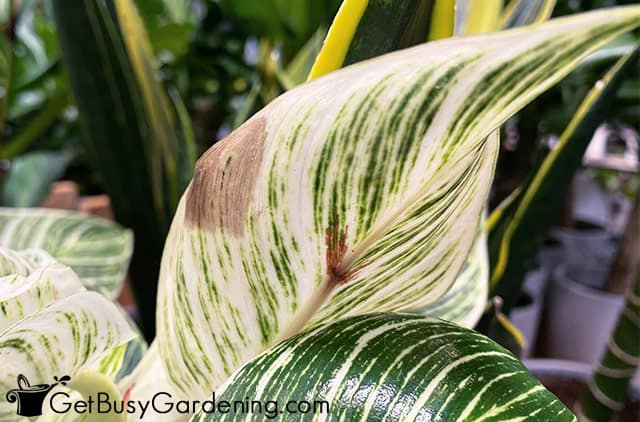
FAQs About Philodendron Birkin Care
Here I’ve answered some of the most commonly asked questions about Philodendron Birkin care. If yours isn’t on the list, please add it to the comments section below.
Is Philodendron Birkin an indoor plant?
Philodendron Birkin makes an excellent indoor plant because it prefers indirect light and a temperature range that is common in homes. Although you can also grow it outside in zones 10+, as long as it stays between 70-85°F.
How big do Philodendron Birkins grow?
Philodendron Birkins can grow to be as big as 3’ tall, with leaves as wide as 7”.
How fast does a Philodendron Birkin grow?
How fast a Philodendron Birkin will grow depends largely on the care and environment it receives. With bright light, proper watering, and consistent fertilizer, they can reach their full mature size in a few years.
Are Philodendron Birkin plants easy to take care of?
Philodendron Birkin plants are easy to take care of once you get the hang of how often to water, the best type of light, and how to provide the right humidity levels.
Is a Philodendron Birkin rare?
The Philodendron Birkin is considered rare because it’s a new cultivar that doesn’t exist in nature. But it’s gaining popularity, so they are available more often these days at nurseries or online.
The beautiful white variegated leaves make this a stunning houseplant that even beginners can grow. Use these Philodendron Birkin plant care tips so you can enjoy yours for many years to come.
If you want to learn all there is to know about maintaining healthy indoor plants, then you need my Houseplant Care eBook. It will show you everything you need to know about how to keep every plant in your home thriving. Download your copy now!
More Houseplant Care Guides
- How To Care For Purple Heart Plant (Purple Queen, Tradescantia pallida)
- How To Care For A Pink Princess Philodendron
- How To Care For Peperomia Plants
- How To Care For Heart Leaf Philodendron (Philodendron hederaceum)
- How To Care For A Pothos Plant (Devil’s Ivy)
Share your Philodendron Birkin care tips in the comments section below.
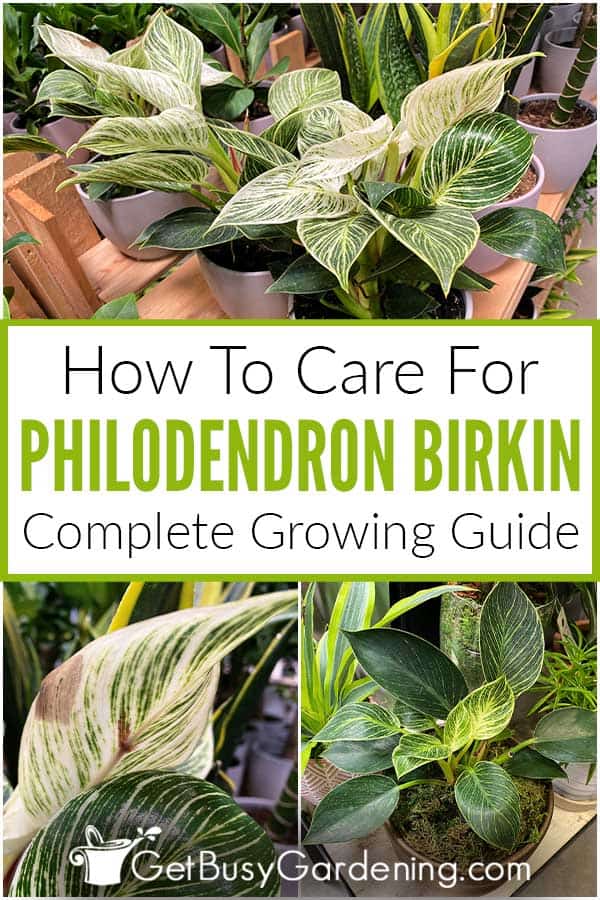
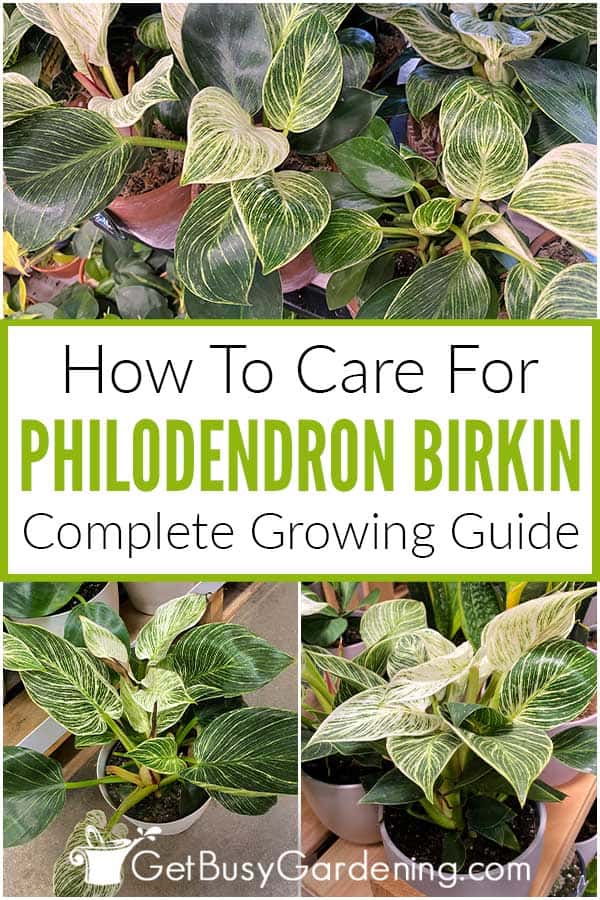




Jake Klippenstein says
I was given a Birkin potted in a pot with underneath watering. I’m noticing now that its getting yellow leaves. Could it be when I fill the bottom with water it keeps the plant continually moist which is actually over watering?
Amy Andrychowicz says
Yes, it sounds like you could be overwatering your Birkin. It’s best to water from the top, because soaking it from the bottom makes it very difficult to tell how wet the rootball is, so it’s easy to overdo it. Stick your finger at least 2″ deep to see if it feels wet, and wait to water it until it dries out a bit. I recommend getting a moisture gauge (link in article), that way you can see how wet the soil is in the bottom of the pot.